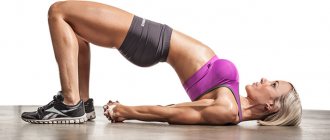Why running is good for weight loss
So, does running help you lose weight? Let's figure it out.
Problems with excess weight are usually typical for people leading a sedentary lifestyle. Moreover, now a good half of the population has personal vehicles. Thanks to cars, we stop not only running, but actually walking. As a result, the body accumulates fat, and the muscles atrophy due to uselessness.
To avoid obesity and unpleasant consequences for your appearance and health, you need to pull yourself together and go for a run. This is the simplest type of physical activity that is available to everyone. And let it be just a brisk walk at first. As soon as your body adapts, start running.
Let's take a closer look at how running burns fat?
Running makes your heart pump faster, which is why it is classified as cardio. With an accelerated heart rate, more blood passes through the heart per unit of time than in a calm state. The lungs also begin to work harder, and your blood is actively enriched with oxygen. Oxygen saturation occurs in all cells of the body, from the tips of the toes to the brain. Metabolic processes begin to proceed faster.
Running requires energy. To ensure its constant influx, the body uses up its internal reserves. First, the glycogen stored in the liver is consumed, then the fatty deposits of our body are used. Therefore, running and excess weight are incompatible concepts. If you move actively and burn more calories than you consume from food, your excess weight will disappear. Running and losing weight are interconnected things.
- For jogging (7-9 kilometers per hour), fat burning begins after 20-30 minutes of continuous running.
- With interval training, the process of fat breakdown begins much earlier; you do not need to run for an hour to start fat catabolism. But interval running is quite a heavy load and this type of cardio is not suitable for everyone.
When talking about whether running helps you lose weight, it is important to clarify its type and duration. If we mean classic jogging at an easy pace, the duration of the workout should be at least thirty minutes.
How long do you need to run to lose belly fat?
The body is designed in such a way that it is impossible to lose weight in one place. Weight loss occurs evenly. Therefore, if you set the goal of getting rid of a big belly, your whole body will become slimmer as a result.
The advantage of running is that all muscle groups are involved. The number of heart contractions increases, which contributes to the development of the circulatory system and the healing of the body. The heart is being trained. After all, the heart consists of the same muscles as those in the arms, legs, and back.
The first weight loss can be observed after 2-5 weeks of regular jogging. The first two workouts will serve as a warm-up for the muscles and activate the increased energy burning mechanism. If you do it systematically, each run will take up more and more weight.
One running workout takes at least 20 minutes. During this period of time, 200-400 calories are burned. The activity is accompanied by the release of sweat. Along with it, excess fluid and subcutaneous fat deposits are removed.
Increasing your running time helps you burn more calories. An hour of continuous running burns about 800-1500 calories. This is equivalent to 1000 grams of eaten cottage cheese with 6% fat content.
Preparing to run
To start running, you don't need to buy expensive accessories, you only need comfortable sneakers and sportswear. That's it, nothing more is needed.
Choose sneakers with soles of medium thickness and softness. The spiked outsole provides good grip on the ground, but you won't be able to run on it for long. If the sole springs too much, it will interfere with your stability. It is permissible to buy sneakers with thin soles in one case, when you will be running on rubberized tracks in a stadium or running alley. You can’t run on asphalt in sneakers, you’ll damage your joints.
The costume can be assembled from simple sweatpants, a T-shirt (undershirt) and a sweatshirt. When the cold weather sets in, you will need a jacket on top, a hat and gloves. All this should be light so that you do not sweat. And if you do sweat, your clothes should wick moisture away well.
Cheap synthetic clothing will not be able to effectively remove moisture and you will sweat in it. More expensive models, called thermal underwear, are capable of doing this. Therefore, if you have a good income, do not skimp on clothes.
If you don't want to buy another jacket, you can get by with a sweater under your sweatshirt. This is a proven option - warm and comfortable.
Mode and nutrition
For beginner runners, it is important to follow a systematic training routine. If you run twice and stop, it won't do any good.
In addition to the jogging regime, you need to reconsider your diet a little - switch to a healthier diet for weight loss. Together with running, it helps to get rid of the stomach and other problem areas faster.
By combining nutrition and running, you can lose weight much faster than through diet or exercise alone.
When you run is up to you. You can practice running every day in the morning or go outside in the evening. The best time to run is when you feel most comfortable. You are a morning person and get up at 6 am – run in the morning! If you are a night owl and are at work or school all day, choose running in the evening. There is no need to run at night. The body should sleep at this time, regardless of whether you are a night owl or a lark.
Jogging for weight loss should be done 3-6 times a week. The duration of your run will depend on how many times a week you exercise. The more often you practice, the shorter the race can last. But remember that since losing weight through running is your main goal, the more and more often you move, the more intense the process will be.
What is more effective: diet or running?
You can find many stories of successful weight loss through dieting. It is worth noting here that there are no universal diets. It will help some people lose weight, but not others or will lead to weight gain. Moreover, no diet can make your body fit. As a rule, the hips become smaller, but continue to hang.
No one gained weight from running, and as a result, the figure becomes much more attractive. No need to starve. In addition to this, your overall well-being improves. Endurance and the circulatory system develop.
The ideal option would be to use diet and running in combination. But the diet should not include fasting. On the contrary, running training requires a large amount of carbohydrates, and they are found in chocolate.
The best diet is to avoid overeating. Compliance with diet. You can eat food 5 times a day, but in small portions.
To lose belly fat, you need to get into the habit of proper nutrition and systematic training. How long it takes depends on the initial weight and the task at hand. Use these tips to increase your calorie burn. Lose weight gradually and without exhausting diets.
Where can you lose fat by running?
Will running help you lose weight in your legs? Since running uses your legs, running is effective for losing weight in your legs first. More precisely, let's put it this way - fat disappears throughout the body, but by training the muscles, your legs will look slimmer and more toned. Proper running for weight loss will also help remove fat from the buttocks, waist, hips and all other problem areas.
There is no such thing as spot removal of fat. Don't expect the fat to magically disappear from just your belly. Indeed, running will, of course, help to remove your belly, but the extra centimeters will go away not only from the waist area, the upper part of the body will also lose weight.
So you don’t have to worry about how to run correctly in order to lose weight in your legs or in some other place - the fat will leave the problem area in parallel with the rest of the body.
Running techniques for weight loss
There are several running techniques that you can use as a means to an end.
Running in place
For the most modest, there is running on the spot at home for weight loss. You need to stand anywhere in your home and run. Running in place for weight loss differs from regular running in that you simply lift your knees up and place your feet on your toes. This is done quickly, you bounce a little on each leg. The arms make the same movements as during real running.
Thus, you can practice running for weight loss without leaving home, without buying special exercise equipment. The only negative is that it is a very boring activity. As Vysotsky sang, “there are no firsts and no lagging behind...”, no competitive incentive. The picture before your eyes does not change, and neighbors below may react negatively to the noise.
However, no matter what anyone says, this running helps you lose weight, just like any other type of cardio. If you have enough patience, you will achieve your goal.
If you want to use running to lose belly fat, you need to raise your knees high. In this case, the lower abdominals are more involved.
Interval running
Interval running is a powerful stimulus for activating catabolic processes in the body.
Its essence is simple: you run for 5 minutes at a normal pace, then accelerate as much as possible for 20–40 seconds, then restore your heart rate and breathing for 2–5 minutes. Next, repeat the acceleration. In one running workout, you can do 4-6 accelerations. As your body allows.
This type of running allows you to quickly lose weight on your stomach and sides and helps burn fat in all problem areas.
The peculiarity is that interval running drives the body into anaerobic limits. The muscles do not have enough oxygen to carry out the normal pathway of glucose oxidation. As a result, an anaerobic process begins in the muscles, as a result of which a metabolite is released - lactic acid, which causes the familiar burning sensation. This is how interval running affects metabolism, it is, so to speak, extreme cardio. Know when to stop, excessive interval running can harm you!
In other words, interval running, for all its effectiveness, has a big disadvantage - not everyone can try it. Contraindications are problems with the heart, lungs, and sore joints. It is also better for beginners to train in traditional ways.
That is, although this is the most effective running for weight loss, due to a number of restrictions it is not the most common.
But the following way to lose weight can be recommended to almost everyone. Note to all runners - jogging is the optimal combination of exercise and safety.
Jogging
This run doesn't push your heart to its limits, but it does take your calorie expenditure to the next level. This is a long, but very useful activity. This kind of running is considered healthy.
Anyone who does not have obvious health problems can jog. After all, this movement is only slightly more intense than walking at a brisk pace.
A person who is losing weight can gradually lose excess weight without harm to the body through regular jogging.
Many of us are more accustomed to going for a run in the morning, but running in the evening is also effective for losing weight. As already noted, the main thing is not to try to train at night, as the body needs to sleep.
This kind of running saves you from cellulite, shortness of breath, pressure surges, and increased fatigue. It also improves mood, stabilizes the nervous system, and saturates cells with oxygen.
There are so many positive aspects to such a simple activity! It's worth incorporating regular jogging into your life, isn't it?
How to run to lose belly fat?
There are ways to increase the number of calories burned and speed up the fat burning process. However, there are conditions that affect this indicator. It is easier for men to lose excess fat than for women. This is due to differences in hormonal levels. Other conditions for the rate of fat burning are age, height and initial weight.
These indicators can slow down the process of fat loss, but cannot stop it completely. Regular exercise will lead to weight loss in any case.
Running pace.
It is clear that you can run slowly and as quickly as possible. And both options are suitable to achieve the goal. The only difference is that slow running allows you to burn more fat and train for a longer time. Running at a fast pace burns more calories and contributes to the formation of relief. However, its duration is noticeably lower.
Effectively perform variable running, alternating between slow and fast paces. But it is better to train in this mode after 2-3 months of training.
Times of Day.
The physiological component of training lies in the period of time of day that is allocated for running.
In the morning, the body better accepts running at a high pace for a short time. This allows you to wake up and prepare the body for the work day.
In the evening, preference should be given to slow running. At this time of day, the body begins to waste fat reserves, as its strength is running out. Increasing muscle volume occurs more effectively in the evening.
Equipment.
The choice of equipment affects the result of running. If your goal is to lose excess fluid, dress warmly. Even if it's summer weather outside. This will allow you to sweat more and lose fluid. Also burn subcutaneous fat.
Weights are used to train muscles and burn fat. They come in the form of ribbons and vests. By artificially increasing your weight, you will lose more than your own.
During your first workouts, it is better to run without weights and insulation. Stretch your muscles and after 2 months you can include these recommendations for accelerating weight loss into your workout.
Fat burning cocktails.
There are cocktails that allow you to speed up the process of burning fat on the stomach, sides, thighs and buttocks. They can be purchased in specialized stores or made independently.
The choice of such a product must be approached with great care and individuality. It is preferable to consult a nutritionist.
Duration and frequency of runs
A reasonable question is, if you use running to lose weight, how much should you run?
Let’s answer it this way: you need to run every other day or 5-6 times a week. Less often - there will be no benefit, more often - you will quickly become overtired.
- The minimum time for each jog should be 30–40 minutes.
- The maximum time for interval running is 20–30 minutes.
The safest and healthiest thing to do is jog every other day for 45–60 minutes at a comfortable pace. This includes muscle work, gradual fat breakdown, and cardio.
As a result, we can say that if your goal is to lose weight, running will become your best friend. But only if you develop an iron habit, because you need to exercise regularly.










